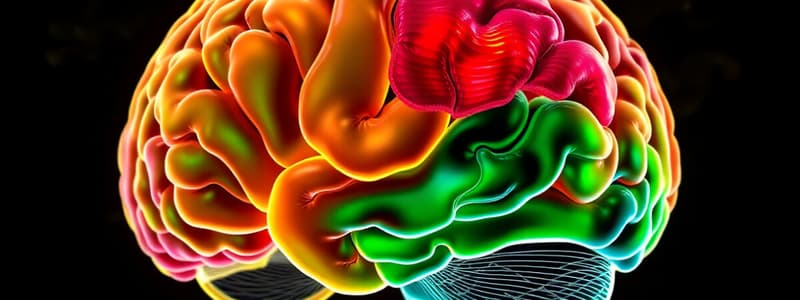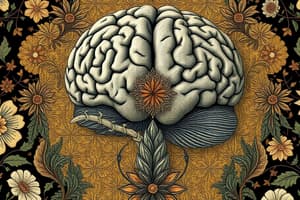Podcast
Questions and Answers
What is the first step in the memory formation process?
What is the first step in the memory formation process?
- Consolidation
- Encoding/Registration (correct)
- Storage/Retention
- Retrieval
What process follows encoding to strengthen memory traces?
What process follows encoding to strengthen memory traces?
- Interference
- Consolidation (correct)
- Reactivation
- Decoding
Which theory suggests that memories degrade over time if not used?
Which theory suggests that memories degrade over time if not used?
- Interference Theory
- Decay Theory (correct)
- Reactivation Theory
- Motivated Forgetting
In the Atkinson-Shiffrin model, which stage comes after Short-Term Memory?
In the Atkinson-Shiffrin model, which stage comes after Short-Term Memory?
What occurs during the retrieval phase of memory?
What occurs during the retrieval phase of memory?
What is an example of proactive interference?
What is an example of proactive interference?
Which of the following best defines 'storage' in the context of memory?
Which of the following best defines 'storage' in the context of memory?
Which memory process involves transforming short-term memories into lasting memories?
Which memory process involves transforming short-term memories into lasting memories?
What is one of the primary functions of the basal ganglia?
What is one of the primary functions of the basal ganglia?
Which type of memory is specifically responsible for storing visual information?
Which type of memory is specifically responsible for storing visual information?
What is the duration of iconic memory retention?
What is the duration of iconic memory retention?
Which part of the brain is primarily involved in decision making and reasoning?
Which part of the brain is primarily involved in decision making and reasoning?
What is the approximate duration of short-term memory?
What is the approximate duration of short-term memory?
Which type of sensory memory is associated with touch-related information?
Which type of sensory memory is associated with touch-related information?
What role does the cerebellum play in brain function?
What role does the cerebellum play in brain function?
In the context of memory formation, what do neurons do?
In the context of memory formation, what do neurons do?
What is the primary function of memory as defined in psychology?
What is the primary function of memory as defined in psychology?
In which brain region are episodic memories primarily formed and indexed?
In which brain region are episodic memories primarily formed and indexed?
Which part of the brain is responsible for processing emotions related to memory?
Which part of the brain is responsible for processing emotions related to memory?
What aspect of memory involves retaining information for later recall?
What aspect of memory involves retaining information for later recall?
What function does the neocortex serve in relation to memory?
What function does the neocortex serve in relation to memory?
Cognition refers to which of the following processes?
Cognition refers to which of the following processes?
What is the role of memory in guiding future actions?
What is the role of memory in guiding future actions?
Which statement accurately defines the process of retrieval in memory?
Which statement accurately defines the process of retrieval in memory?
What is the main characteristic of short-term memory (STM)?
What is the main characteristic of short-term memory (STM)?
What does the term 'chunking' refer to in memory processes?
What does the term 'chunking' refer to in memory processes?
What type of mnemonic device utilizes imagery to aid memory?
What type of mnemonic device utilizes imagery to aid memory?
Which of the following is NOT a feature of long-term memory (LTM)?
Which of the following is NOT a feature of long-term memory (LTM)?
Which category does episodic memory belong to?
Which category does episodic memory belong to?
What does the acronym PEMDAS stand for in relation to memory?
What does the acronym PEMDAS stand for in relation to memory?
Which of the following best describes implicit memory?
Which of the following best describes implicit memory?
What is a major feature of mnemonic devices?
What is a major feature of mnemonic devices?
What occurs during encoding failure?
What occurs during encoding failure?
Which phenomenon exemplifies retrieval failure?
Which phenomenon exemplifies retrieval failure?
What does the Memory Trace Theory suggest?
What does the Memory Trace Theory suggest?
The Information Processing Theory outlines that memory begins with which phase?
The Information Processing Theory outlines that memory begins with which phase?
How long does information typically remain in short-term memory according to the Information Processing Theory?
How long does information typically remain in short-term memory according to the Information Processing Theory?
In the context of HCI, understanding human memory is crucial for which reason?
In the context of HCI, understanding human memory is crucial for which reason?
What is a key characteristic of human memory in relation to HCI?
What is a key characteristic of human memory in relation to HCI?
Which statement is true regarding the general theories of memory function?
Which statement is true regarding the general theories of memory function?
Flashcards are hidden until you start studying
Study Notes
Memory
- Psychology defines memory as the mind's ability to encode, store, and retrieve information.
- Memories are a record of past experiences that guide future actions.
- Memory is simply sensory input received from the environment.
- Cognition is the processing of environmental information gathered through our senses.
- Memory is the ability to encode, store, retain, and recall information and past experiences in the brain.
Where are memories stored?
- The hippocampus, located in the temporal lobe, is the brain region where episodic memories are formed and indexed.
Parts of the brain involved in memory
- Hippocampus: Forms and indexes episodic memories for later access.
- Neocortex: Controls higher functions including sensory perception, motor commands, spatial reasoning, and language.
- Amygdala: Major processing center for emotions.
- Basal Ganglia: Primarily involved in motor control, also responsible for motor learning, executive functions, and behavior, and emotions.
- Cerebellum: Coordinates voluntary movement, balance, and posture.
- Pre-frontal Cortex: Part of the neocortex at the front of the brain; involves decision making, reasoning, personality, social appropriateness, and complex cognitive processes.
How are memories stored?
- Memories are made of different neurons (nerve cells) that encode memories and control thoughts and perceptions.
- Brain cells called neurons activate and form connections, creating neural patterns that represent memories.
Structures of Human Memory
- Sensory memory: Acts as a buffer for incoming sensory information, retaining it briefly.
- Iconic memory: Stores visual information for 0.5 to 3 seconds.
- Echoic memory: Stores auditory information for 3 to 4 seconds.
- Haptic/Tactile memory: Stores touch-related information for 1 to 2 seconds.
- Short-term memory (STM): Temporary storage system that processes incoming sensory memory.
- Lasts approximately 20 to 30 seconds.
- Used for storing information that is only needed fleetingly.
- Capacity is limited but access is rapid.
- Decays rapidly with a limited capacity of 5 to 9 chunks of information.
- A chunk is a unit of information, which can be a single item or group of items.
- Chunking can increase short-term memory capacity.
Mnemonic Devices
- Memory aids to assist in the retention and retrieval of information.
- Visual mnemonic devices: Rely on imagery.
- More whimsical and creative devices are more effective.
- Acrostics/Acronyms:
- Acrostic: Uses the first letter of each line to spell out a word.
- Acronym: Shortens phrases using initials.
- Rhyming mnemonics: Put information into poetry form.
Long-Term Memory (LTM)
- Vast store of knowledge and records of prior events.
- Duration ranges from weeks, months, years, or decades.
- Unlimited capacity, slow access time, and forgetting occurs slower or not at all.
- Two types of long-term memory:
- Explicit memory (Declarative Memory): Conscious recall of information like facts, events, and experiences.
- Episodic memory: Memories of events and experiences.
- Semantic memory: Structured record of facts, concepts, and skills derived from episodic memory.
- Implicit memory (Procedural memory): Unconscious recall of skills, habits, and conditioned responses.
- Explicit memory (Declarative Memory): Conscious recall of information like facts, events, and experiences.
Nature of Memory
- Memory has essential characteristics:
- Input (Encoding): Process of creating or taking in new information to create a new memory.
- Storage: Process of holding or storing information for retrieval.
- Output (Retrieval): Process of accessing stored memory.
Processes of Human Memory
- Memory is a complex process involving learning, retention, recall, and recognition. Memorization has four distinct processes:
- Encoding/Registration: Translates sensory information into a coded form for easy storage and reproduction.
- Information is transformed into engrams and codes.
- Consolidation: Strengthens the memory trace by transforming short-term memories into more stable long-term memories.
- Storage/Retention: Storing memories in various brain regions based on type.
- Involves long-lasting changes in synaptic connections, forming what's known as a neural network.
- Retrieval: Process of accessing stored memories when needed.
- The brain reactivates the memory’s neural pattern formed during encoding and consolidation during storage.
Models of Memory
- Atkinson-Shiffrin Model of Memory: Developed by Richard Atkinson and Richard Shiffrin (1968). Memory must pass through three stages:
- Sensory memory
- Short-term memory
- Long-term memory
Why Do We Forget? Five Theories of Forgetting
- Decay Theory: Memory degrades over time if not actively used.
- Interference Theory: One memory competes or interferes with another.
- Retroactive interference: New information overlaps old information.
- Proactive interference: Old information overlaps new information.
- Motivated Forgetting: People actively or subconsciously forget unpleasant memories, possibly a coping mechanism.
- Encoding Failure: Information was never properly inserted or encoded into long-term memory.
- Retrieval Failure: Memory exists but the necessary triggers or cues to recall it are missing.
- The "tip-of-the-tongue" phenomenon.
Human Memory in HCI
- Human memory is a psychological process enabling users to encode, store, and retrieve information when interacting with computer systems and digital interfaces.
- Understanding how memory works helps designers create user-friendly (usable) interfaces that align with user cognitive capabilities.
Theories of Memory
- Memory Trace Theory: Everything we encounter or experience is recorded in the form of memory traces.
Theories of General Memory Function
- Most psychologists agree that memory involves three distinct processes:
- Encoding
- Storage
- Retrieval
Information Processing Theory
- Developed by Richard Atkinson and Richard Shiffrin.
- Memory begins with sensory input from the environment, which is held very briefly in the sensory register.
- Information recognized in the sensory register might then be passed to short-term memory (20 to 30 seconds).
- Some of the information transferred to short term memory is processed by being rehearsed.
Studying That Suits You
Use AI to generate personalized quizzes and flashcards to suit your learning preferences.




